Why are aerial lift OEMs taking steps to adopt hydrogen power?
07 January 2025
Access equipment giants, including Haulotte, Niftylift and Manitou, have developed hydrogen-powered equipment using different approaches. Rental Briefing takes a deep dive into the topic.
France-based Haulotte’s journey to adopt hydrogen energy began in June 2022 when it announced a collaboration with Bouygues Energies & Services, a subsidiary of Bouygues Construction, which completed the acquisition of hydrogen solutions specialist Equans in October of the same year.
“Haulotte decided in 2018 to switch all its machines to electrical mode,” Benoît Baleydier, project manager at Haulotte, tells IRN.
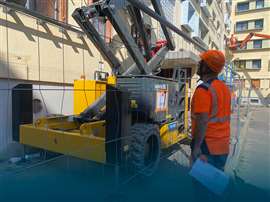 Haulotte’s HS18 E PRO scissor lift is powered by a hydrogen fuel cell. (Photo: Haulotte)
Haulotte’s HS18 E PRO scissor lift is powered by a hydrogen fuel cell. (Photo: Haulotte)
“The electric HS18 E was launched in 2021 from what was historically a diesel machine,” he says. “We had a removable diesel range extender.”
According to Haulotte’s website, the diesel range extender is a removable power generator that can recharge a scissor lift’s battery to 80% in three hours.
Following the partnership with Bouygues, Baleydier says the removable diesel range extender can now be replaced with a hydrogen fuel cell version of the same size and electricity generation capability.
Haulotte used the hydrogen range extender on site for the first time in October 2024 on its rough terrain HS18 E PRO scissor lift at the Saint-Cyr-l’École military school near Paris. Equans is the hydrogen gas supplier for this trial program, which commenced in May of the same year.
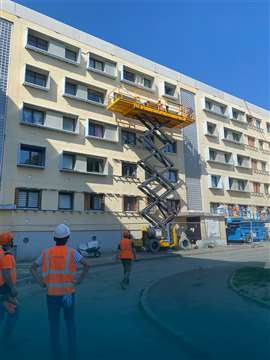 Haulotte’s HS18 E PRO scissor lift was used for the first time at the Saint-Cyr-l’École military school near Paris in October 2024. (Photo: Haulotte)
Haulotte’s HS18 E PRO scissor lift was used for the first time at the Saint-Cyr-l’École military school near Paris in October 2024. (Photo: Haulotte)
“Technically speaking, hydrogen fuel cell technology is mature. But today’s regulations are not mature enough,” Baleydier says. “Today, we only deal with the regulations for one machine prototype and construction site. But we cannot deal with the regulations for tomorrow’s mass production because they are too complicated.”
He adds that current regulations and safety guidelines for storing hydrogen gas on construction sites must be updated before it can be used effectively.
In addition, says Baleydier, “From an economic point of view, the fuel cell technology is too expensive to justify the costs of its usage today.
“We are now working with several suppliers to find out how to reduce the costs of this technology.”
He adds that Haulotte hopes to make some progress in lowering the costs during 2025.
“One thing we know is that there will not only be one energy source in the future,” he says. “We want to be sure we will be ready for the future, so we launched this project to check the regulations, technical issues, and market response.”
Long refuelling time
Since the Haulotte-Equans trial program began in May, many customers have been amazed that a hydrogen fuel cell can replace a diesel power generator as a range extender to increase the autonomy of battery machines, Baleydier says.
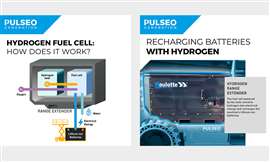 Haulotte’s hydrogen fuel cell (Credit: Haulotte)
Haulotte’s hydrogen fuel cell (Credit: Haulotte)
“The only thing they ask us to improve is the time for refuelling the machine.
“They told us that this is acceptable for an experiment, but we need to improve the refuelling system for mass production and daily use.”
Equans developed the refuelling system without an intermediate tank due to regulatory constraints. According to Baleydier, refuelling will be faster once the system can pressurise hydrogen from 200 to 400 bar in advance and store it in the intermediate tank at about 350 bar.
He says Haulotte had considered using removable hydrogen gas tanks in its range extender but did not pursue it because this would require qualified staff to change the tanks frequently.
Removable tanks
In June 2023, UK-based rental firm Speedy Hire and MEWP manufacturer Niftylift launched the world’s first hydrogen fuel cell-powered access platforms, HR15E and HR17E.
According to Speedy Hire, the two machines can typically be operated for up to five days on a single electric charge, with a significant additional range available from the hydrogen fuel cell.
Niftylift said hydrogen combustion is only 25-35% efficient in energy conversion, but a hydrogen fuel cell can be as high as 60% efficient. It added that refuelling is straightforward - connect to a G20 Hydrogen bottle to fill up the fuel cell.
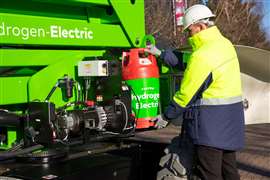 Niftylift says the training for replacing hydrogen gas tanks is not complicated. (Photo: Niftylift)
Niftylift says the training for replacing hydrogen gas tanks is not complicated. (Photo: Niftylift)
“We use removable tanks,” Tom Hadden, Technical Sales Manager at Niftylift, tells IRN in an interview. “Once you’ve depleted the cylinder, you can change it like a gas barbecue.
“A level of training is required, but it’s not that you have to do a 10-day course on this,” he says. “In competency-based training, you can be trained within a morning.”
“All the connections we use do not involve tooling as they’re either hand-tied or push-fit connectors,” he adds. “You don’t have to have a mechanical engineering degree to change your cylinder.”
Hadden says many larger utilization-type products, such as earth-moving excavators, have adopted hydrogen combustion engines, and most industry players are not planning to build hydrogen combustion engines smaller than 50-55 kilowatts.
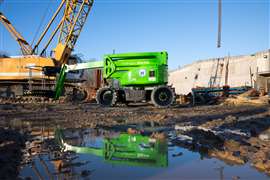 Niftylift’s hydrogen fuel cell-powered boom lift HR15 (Photo: Niftylift)
Niftylift’s hydrogen fuel cell-powered boom lift HR15 (Photo: Niftylift)
“This takes us out of that market as we only use 19-kilowatt engines, but then we realise we don’t need it,” he says, adding that an excavator operator digs and moves all day while an access platform operator only needs to move into a position and go up in the air to stay there for an hour or two.
While Niftylift has ruled itself out of hydrogen combustion and decided to focus on hydrogen fuel cell technology, the initial lack of industry standards and governing body guidance on hydrogen fuel cells in machines remains a key challenge. Besides, says Hadden, there are not many fuel cell suppliers worldwide.
“We are looking at extending our range in 2025,” he says. “We have spoken to another fuel cell supplier and agreed to do an urban development program.”
Niftylift is seeking fuel cells with larger outputs to cover all its self-propelled lift platforms from 12 to 28 meters, he says.
New products in Bauma
Other access equipment makers also plan to launch new hydrogen fuel cell-powered products in 2025.
Manitou Group, the French manufacturer of telehandlers and aerial platforms, tells IRN that it will have something new to show at the Bauma trade show in Germany in April 2025.
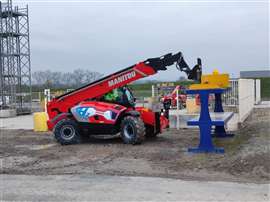 Manitou unveiled its first prototype hydrogen telehandler in December 2022. (Photo: Manitou)
Manitou unveiled its first prototype hydrogen telehandler in December 2022. (Photo: Manitou)
In December 2022, the company unveiled its first prototype hydrogen fuel cell-powered telehandler, based on an existing model with a 14-meter height range. It says the production of a 100% hydrogen-powered telehandler will be ready by 2026.
The company also set up a hydrogen station to test its prototype telehandlers for range and reliability in real-life conditions. It says it would offer its electric and hydrogen ranges side-by-side, aiming to have 43% of its products be low-emission machines by 2030.
“The green hydrogen sector is gradually becoming more established with the entry of a number of players into this market,” says Julien Waechter, vice president of R&D at Manitou Group.
“All of the aid mechanisms proposed by the different governments will encourage the transition to hydrogen and will speed up the development of the distribution network and ultimately the reduction in the usage costs of our machines using this energy.”
STAY CONNECTED



Receive the information you need when you need it through our world-leading magazines, newsletters and daily briefings.
CONNECT WITH THE TEAM







